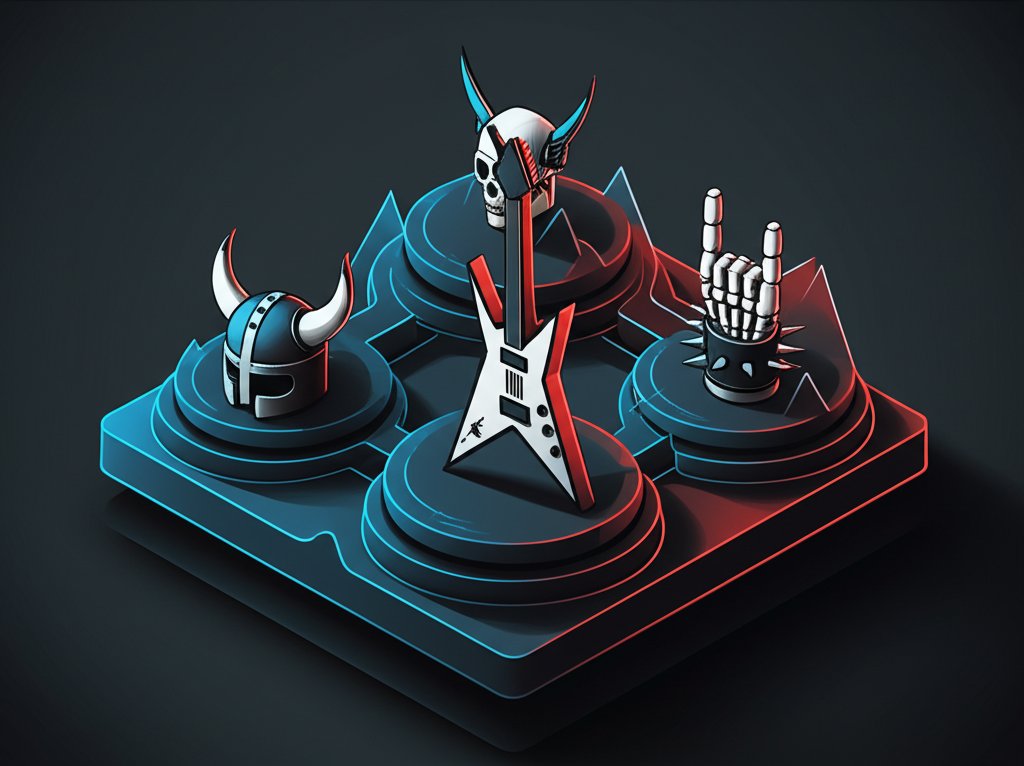Embark on an electrifying journey through the thunderous world of metal music. From its raw, rebellious origins in the industrial towns of the late 1960s to its intricate, diverse subgenres spanning the globe today, the sejarah musik metal is a testament to unwavering passion, innovation, and an unyielding spirit. This comprehensive guide will not only trace the evolusi musik metal decade by decade but also deep-dive into the myriad of subgenre metal that have shaped its enduring legacy, ensuring you gain a world-class understanding of this captivating genre. Prepare to explore the sound, the culture, and the iconic figures that forged heavy metal into a global phenomenon.
The Roaring Overture: Genesis of Metal Music (Late 1960s – Early 1970s)

The foundations of heavy metal were not laid in a vacuum. They emerged from a potent cocktail of blues rock, psychedelic rock, and hard rock, amplified by economic anxieties and social change. The desire for a heavier, more aggressive sound resonated deeply with a generation seeking escape and expression.
Understanding the evolution of metal requires appreciating its place within the broader landscape of music history, a timeline you can further explore to contextualize its rise and impact, seeing how other genres influenced or were influenced by its development.
Blues Roots & Proto-Metal Pioneers
Before the term “heavy metal” even existed, its sonic precursors were bubbling in the late 1960s. Bands like Cream, The Jimi Hendrix Experience, and Led Zeppelin began pushing the boundaries of amplification, distortion, and raw power. Jimi Hendrix’s innovative use of feedback and wah pedal, Led Zeppelin’s colossal riffs and mythical lyrics, and Cream’s blues-infused improvisations laid crucial groundwork. Bands like Steppenwolf even coined the term “heavy metal thunder” in their 1968 song “Born to Be Wild,” unknowingly prophesying the genre’s arrival. This period saw the deliberate use of heavy guitar riffs and a more aggressive vocal style, deviating from the pop sensibilities of the time.
Black Sabbath: Forging the Blueprint of Heavy
While many contributed to the nascent sound, it was Birmingham, England’s Black Sabbath who truly forged the distinct metal music blueprint in the early 1970s. Their self-titled debut album in 1970, with its dark, doom-laden riffs (often tuned down for an even heavier sound), Ozzy Osbourne’s eerie vocals, and lyrics exploring themes of war, horror, and the occult, set them apart. Tony Iommi’s innovative guitar playing, characterized by heavy, repetitive riffs, became the cornerstone of the genre. They weren’t just playing loud rock; they were creating a new sonic language – a menacing, powerful sound that offered a cathartic release for many and established the grim aesthetic that would come to define much of metal. Black Sabbath’s uncompromising sound provided the definitive launching pad for the entire genre, initiating the true sejarah musik metal.
The Golden Age and Global Expansion (Mid 1970s – 1980s)
The 1970s saw the initial explosion, but the 1980s became the decade where metal truly diversified and took over the airwaves, demonstrating a significant phase in the evolusi musik metal. From the underground to the mainstream, the genre demonstrated incredible adaptability and creative fertility.
NWOBHM: The British Steel Resurgence
As punk rock shook the UK, a new generation of British bands, tired of punk’s simplicity and seeking more musicality and power, revitalized the heavy metal scene. The New Wave of British Heavy Metal (NWOBHM), emerging in the late 1970s, injected speed, melodicism, and a sophisticated dual-guitar attack into the established heavy sound. Bands like Iron Maiden (with their galloping rhythms and epic storytelling), Judas Priest (pioneering the leather and studs aesthetic and dual-guitar harmonies), and Saxon refined the genre, focusing on technical prowess and anthemic songwriting. NWOBHM’s influence was immense, inspiring countless bands globally and setting the stage for faster, more complex forms of metal music.
Thrash Metal: Speed, Aggression, and a New Ethos
Inspired heavily by NWOBHM’s speed and punk’s aggression, Thrash Metal emerged in the early 1980s, primarily from the American West Coast. This subgenre metal pushed tempos to blistering speeds, featuring intricate, often palm-muted guitar riffs, aggressive vocals, and lyrics that tackled social injustice, war, and political corruption. The “Big Four” – Metallica, Slayer, Megadeth, and Anthrax – became synonymous with thrash. Metallica’s “Master of Puppets” (1986) and Slayer’s “Reign in Blood” (1986) are considered landmark albums that propelled thrash into mainstream recognition, marking a pivotal, high-energy point in the evolusi musik metal.
Hair/Glam Metal: Mainstream Domination and MTV
As thrash dominated the underground, another subgenre metal, Hair Metal (or Glam Metal), took over the mainstream. Originating on the Sunset Strip in Los Angeles, this style blended heavy metal riffs with catchy pop melodies, soaring vocals, and a flamboyant, image-conscious aesthetic. Bands like Mötley Crüe, Poison, Bon Jovi, and Def Leppard achieved massive commercial success, dominating MTV and radio airwaves. Their anthemic choruses and often party-oriented lyrics introduced metal music to a wider audience than ever before, albeit with a sound and image often criticized by purist metalheads. This era was crucial for metal’s global recognition, despite its polarizing nature.
Power & Progressive Metal: Technicality and Fantasy
The 1980s also saw the rise of more technically demanding and melodically rich subgenre metal. Power Metal, with bands like Helloween and Blind Guardian, embraced epic themes, high-pitched operatic vocals, fast tempos, and a strong emphasis on melody and harmony. Meanwhile, Progressive Metal, spearheaded by bands like Queensrÿche and Dream Theater, injected complex song structures, unconventional time signatures, extended instrumental passages, and virtuoso musicianship, elevating metal to new heights of technicality and intellectual depth. These subgenres catered to listeners who appreciated both the power of metal and the intricate artistry of progressive rock.
The Age of Diversification: Subgenres Emerge and Evolve (1990s – Early 2000s)
The 1990s witnessed an unprecedented explosion of subgenre metal, as bands pushed the boundaries of extremity, experimented with fusion, and reacted to the changing musical landscape. This period truly solidified the concept of metal as a multi-faceted genre, demonstrating the incredible variety within musik metal.
Death & Black Metal: The Extreme Frontiers
Reacting against the mainstream appeal of glam metal, Death Metal and Black Metal emerged from the extreme underground. Death Metal, characterized by guttural vocals, blast beats, highly distorted, dissonant riffs, and often morbid or violent lyrical themes, was pioneered by bands like Death, Cannibal Corpse, and Morbid Angel. Black Metal, with its raw production, tremolo picking, shrieked vocals, and themes derived from Norse mythology, anti-Christianity, and atmospheric darkness, found its roots in bands like Venom, Bathory, and later, the Norwegian scene with Mayhem and Burzum. These subgenres represent the most uncompromising and controversial facets of metal music.
Groove Metal & Nu Metal: Rhythmic Power and Mainstream Crossover
The mid-1990s brought forth Groove Metal, a subgenre metal that emphasized mid-tempo, percussive riffs, often with a “groovier” feel than thrash. Bands like Pantera and Machine Head reduced the reliance on blistering speed in favor of sheer rhythmic power, heavy breakdowns, and a more aggressive, yet accessible, sound.
Following this, Nu Metal dominated the late 1990s and early 2000s, blending heavy metal with elements of hip-hop, funk, alternative rock, and industrial music. Bands like Korn, Deftones, Slipknot, and Linkin Park utilized downtuned guitars, rap-influenced vocals, turntables, and often angst-ridden, introspective lyrics, attracting a massive new audience to metal music and pushing the evolusi musik metal into unexpected, commercially successful directions. Despite mixed reactions from traditionalists, Nu Metal’s cultural impact was undeniable.
Metalcore & Industrial Metal: Blending Boundaries
The fusion trend continued with Metalcore, which effectively blended the aggressive breakdowns and heavy riffing of metal with the raw, emotional energy of hardcore punk. Bands like Killswitch Engage, August Burns Red, and Parkway Drive defined this subgenre metal with their melodic guitar leads, clean/scream vocals, and mosh-pit-inducing rhythmic structures.
Simultaneously, Industrial Metal (pioneered by bands like Ministry and Nine Inch Nails, later popularized by Rammstein), integrated electronic sounds, samples, synthesizers, and often stark, mechanical rhythms with metal’s aggression, creating a dark, dystopian, and highly theatrical sound. These developments showcased metal’s continuous willingness to embrace diverse influences and evolve.
Gothic & Symphonic Metal: Melodic Darkness and Grandiosity
For those who appreciated melody and atmosphere, Gothic Metal emerged, combining metal’s power with gothic rock’s melancholic mood, often featuring female operatic vocals and lush arrangements (e.g., Paradise Lost, Type O Negative). This naturally evolved into Symphonic Metal, a subgenre metal that fully embraced classical orchestration, choirs, and soaring female vocals to create a grand, cinematic sound. Bands like Nightwish, Within Temptation, and Epica became renowned for their epic storytelling and powerful, theatrical performances, demonstrating the emotional breadth within musik metal.
Metal in the 21st Century: Innovation, Digital Impact & Global Reach

The new millennium has seen metal continue its relentless evolusi musik metal, branching into even more specialized niches while globalizing its reach and adapting to the digital landscape.
Djent, Prog-Metal Revival, and Modern Extremes
The 2000s and 2010s gave rise to new technical subgenre metal like Djent, characterized by heavily palm-muted, multi-string guitar riffs, polyrhythms, and often progressive structures. Bands like Meshuggah (often cited as the progenitors), Periphery, and TesseracT pushed the boundaries of technicality and rhythmic complexity. The broader Progressive Metal genre also experienced a significant revival with bands like Opeth and Gojira gaining widespread acclaim, proving that complexity and heaviness could coexist with commercial success. Extreme metal continues to innovate with sub-subgenres like atmospheric black metal and technical death metal, maintaining its underground vitality.
The Digital Revolution: Accessibility and Community
The digital age has fundamentally transformed metal music. Streaming services, online communities, and social media have made metal more accessible globally than ever before. Bands can connect directly with fans, bypass traditional gatekeepers, and distribute their music independently. YouTube has become a crucial platform for discovering new bands, guitar playthroughs, and metal documentaries. This digital connectivity has fostered an even stronger, more interconnected global metal community, allowing niche subgenre metal to thrive and cross borders instantaneously.
Global Influence: Beyond Western Shores
While its origins were largely Western, metal music has truly become a global phenomenon. Bands performing in their native languages, incorporating traditional instruments and cultural themes, have emerged from every continent. From Sepultura (Brazil) to Chthonic (Taiwan), Babymetal (Japan) to Orphaned Land (Israel), metal has proven its universality and adaptability, demonstrating that its powerful message transcends linguistic and cultural barriers. The sejarah musik metal is increasingly a global one.
The Enduring Legacy and Cultural Impact of Metal Music
Beyond the riffs and solos, metal music has forged a powerful, self-sustaining culture. Its influence extends far beyond mere sound, shaping identities, challenging norms, and inspiring various forms of artistic expression.
A Community, A Lifestyle, An Identity
For millions, metal is more than just music; it’s a way of life, a subculture defined by shared values of authenticity, individuality, and a fierce loyalty to the genre. Metalheads often form tight-knit communities, united by their passion for the sound and the camaraderie found at concerts, festivals, and online forums. It offers an outlet for aggression, a celebration of strength, and a rejection of the mundane, embodying a powerful sense of belonging and identity that few other genres can rival. The shared experience of musik metal creates a powerful bond.
Influence on Art, Fashion, and Beyond
The aesthetic of metal music has deeply permeated popular culture. From the iconic album art that often features elaborate fantasy, horror, or socio-political themes, to the distinctive fashion of band t-shirts, leather jackets, long hair, and tattoos, metal has carved out a unique visual identity. Its themes and sounds have influenced film soundtracks, video game scores, and even served as the backdrop for academic studies exploring its sociological and psychological dimensions. The profound impact of metal underscores its significance as a truly dominant cultural force.
Academic Recognition and Future Horizons
What began as a rebellious, often misunderstood sound has now gained significant academic recognition. Universities offer courses on heavy metal history and culture, and scholarly articles dissect its complex themes and musical structures. This acceptance into the academic sphere speaks volumes about the depth and artistic merit of the genre. Looking forward, the evolusi musik metal is far from over. With new bands constantly emerging, pushing boundaries, and fusing elements, metal music promises a future as vibrant, diverse, and powerful as its storied past.
Conclusion
The journey through the sejarah musik metal reveals a genre of unparalleled resilience, innovation, and intense passion. From the pioneering sounds of Black Sabbath to the extreme and symphonic flourishes of today’s diverse subgenre metal, this powerful form of expression has continually adapted, diversified, and captivated millions worldwide. Metal music is more than just a collection of songs; it is a global culture, a force of nature, and an ever-evolving testament to the human spirit’s need for powerful, uncompromising sound. As long as there are stories to tell, emotions to express, and a desire for music that truly resonates, the thunderous legacy of metal will undoubtedly continue to dominate.
FAQ
Q1: When did heavy metal music first originate?
A1: Heavy metal music originated in the late 1960s and early 1970s, primarily in the United Kingdom, with bands like Black Sabbath being widely credited for shaping its distinct sound.
Q2: What are the primary musical characteristics of metal music?
A2: Metal music is generally characterized by highly distorted, often low-tuned electric guitars, powerful and often aggressive vocals (ranging from clean to growls or shrieks), strong rhythmic drive from drums and bass, and varied tempos. Emphasis is often placed on riffs, solos, and complex song structures.
Q3: How has the evolusi musik metal been influenced by technology?
A3: The evolusi musik metal has been significantly impacted by technology. Advances in amplification and distortion pedals were crucial in its birth. Later, digital recording, software, and the internet (streaming, social media, online communities) expanded its reach, democratized distribution, and fostered global subcultures, allowing niche subgenre metal to thrive.
Q4: Can you name some of the most influential subgenre metal?
A4: Absolutely. Key subgenre metal include Thrash Metal (Metallica, Slayer), Death Metal (Death, Cannibal Corpse), Black Metal (Mayhem, Emperor), Power Metal (Helloween, Blind Guardian), Progressive Metal (Dream Theater, Opeth), Nu Metal (Korn, Slipknot), and Metalcore (Killswitch Engage, Parkway Drive). Each offers a unique sonic identity within the broader metal spectrum.
Q5: What socio-cultural factors contributed to the rise of heavy metal?
A5: The rise of heavy metal was influenced by working-class disenfranchisement, a desire for heavier and louder music exceeding rock, and a fascination with darker, more serious themes in an era of social and political upheaval. The music provided a cathartic outlet and a sense of identity for many.
Q6: What is the significance of the New Wave of British Heavy Metal (NWOBHM)?
A6: NWOBHM, emerging in the late 1970s, was critical for the evolusi musik metal. Bands like Iron Maiden and Judas Priest injected speed, technicality, and melodicism, refining the genre’s sound, inspiring countless bands worldwide, and setting the stage for faster, more complex metal styles like thrash.
Q7: Is metal music still evolving today?
A7: Yes, metal music is continually evolving. Modern subgenre metal like Djent and the ongoing innovation within progressive and extreme metal scenes demonstrate a vibrant and active evolution. The genre continues to incorporate new sounds, technologies, and global influences, ensuring its continued relevance and growth.










